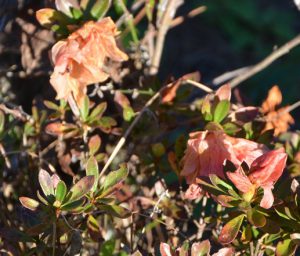This winter’s exceptional weather has deceived some popular springtime ornamental shrubs and fruit trees into flowering prematurely. Azaleas, for example, began blooming because of winter temperatures mush warmer than average.
There are number of variables which determine when a plant will bloom each year, including the sun, water, and air temperature. To understand why the plants bloom, there should be an understanding of “photoperiodism”, meaning the effects of light and darkness on some plant species.
Certain plants respond to the day length. Some are long day plants which flower in spring and summer, and some are short day plants flowering in fall and winter. Then there are plants which will bloom in any season, identified as day neutral plants.
Long and short day plants will not be directly affected by prevailing weather conditions. For example chrysanthemums, which are short day plant naturally bloom in winter.
These plants can be forced to bloom in summer by keeping them in a dark room for 12 hours a day for several weeks. Many nurseries supplying florist uses this technique and utilize greenhouses with blackout systems. They also use grow lights to produce early season blooms on spring/summer flowers sold for Valentine Day.
For those neutral day plants there is “vernalization”. These plants must be exposed to cold weather to some greater or lesser amount.
Most temperate fruit trees need exposure to cold temperatures. When winters are too mild or contain intermittent warmer periods, dormancy is prematurely terminated and bud break starts.
Most of the exposed buds of these fruit trees can survive freezing temperatures, but many of their flowers will be killed if exposed to a late arriving hard freeze or frost.
After the freeze most of the flowers may appear normal, but the center part of the flower where the reproductive organs reside are killed and result in no fruit formation. Covering plants in-bloom provides some freeze protection.
With a warm early winter, like December 2016, there has been irregular and premature flowering.
Another consideration is fruit trees or shrubs pruned too early winter. Warm weather combined with the pruning stimulates the growth of new shoots.
There is a hormone produced in lateral or terminal shoot buds which travels down the shoots inhibiting their growth. When the terminal shoots are pruned too early the growth inhibiting hormone is removed.
The warm days during winter may cause these newly pruned plants to form new shoots. The new growth is tender and very susceptible to freeze injuries. Pruning in late January or February will likely deliver the best results.
For shrubs like azaleas and gardenias, flower buds are set in summer, long before they can be identified by most people. Losing the buds, no matter the cause, after midsummer drastically decreases the number of flowers the following spring.
To learn more about the spring bloom for 2017, visit the UF/IFAS County Extension website
By: Gohar Umar, FAMU Extension Horticulture Specialist, and Les Harrison, Wakulla County Extension Director
Photo caption: Local azaleas were prematurely blooming
- Get Your Trees Ready For The Winds of October - October 8, 2019
- Feeding Caterpillars Aren’t Always Cute - August 10, 2018
- Wild Azaleas - May 23, 2018

